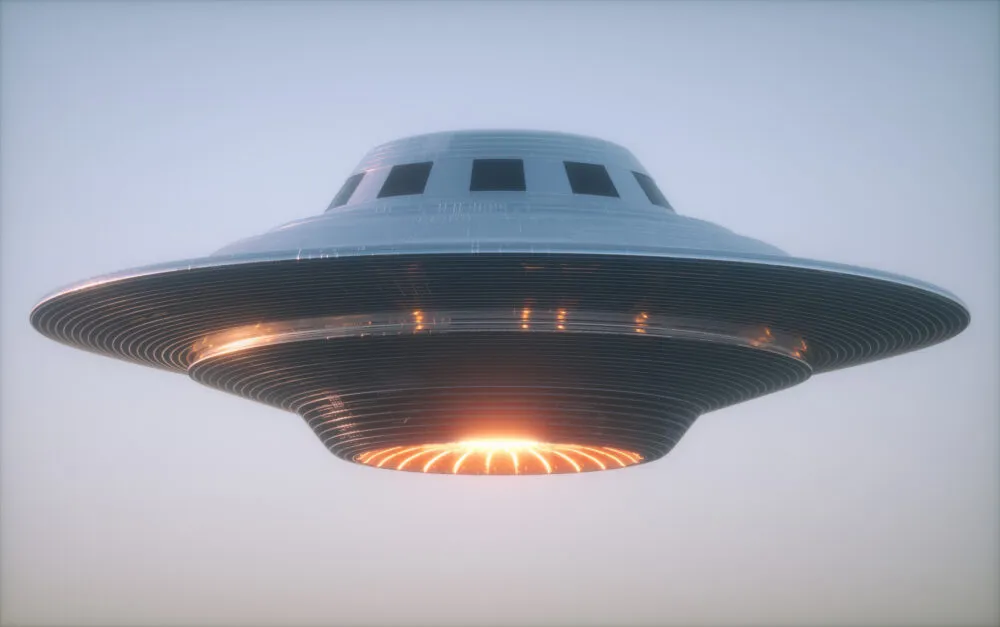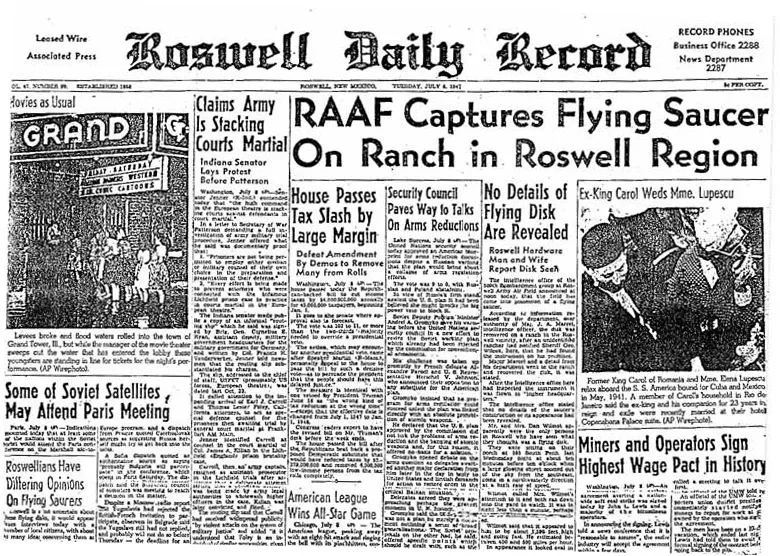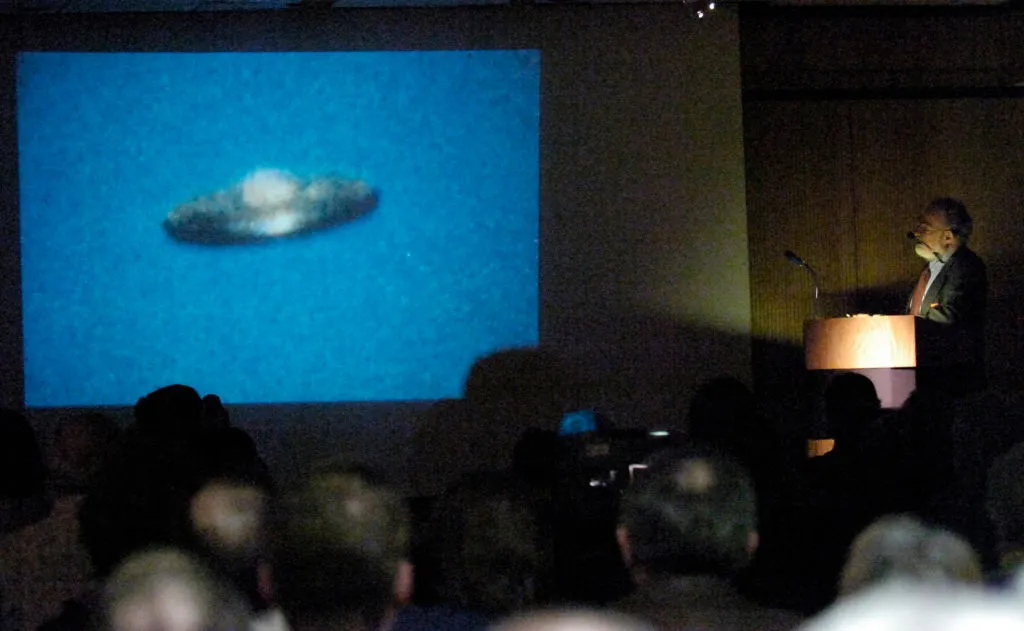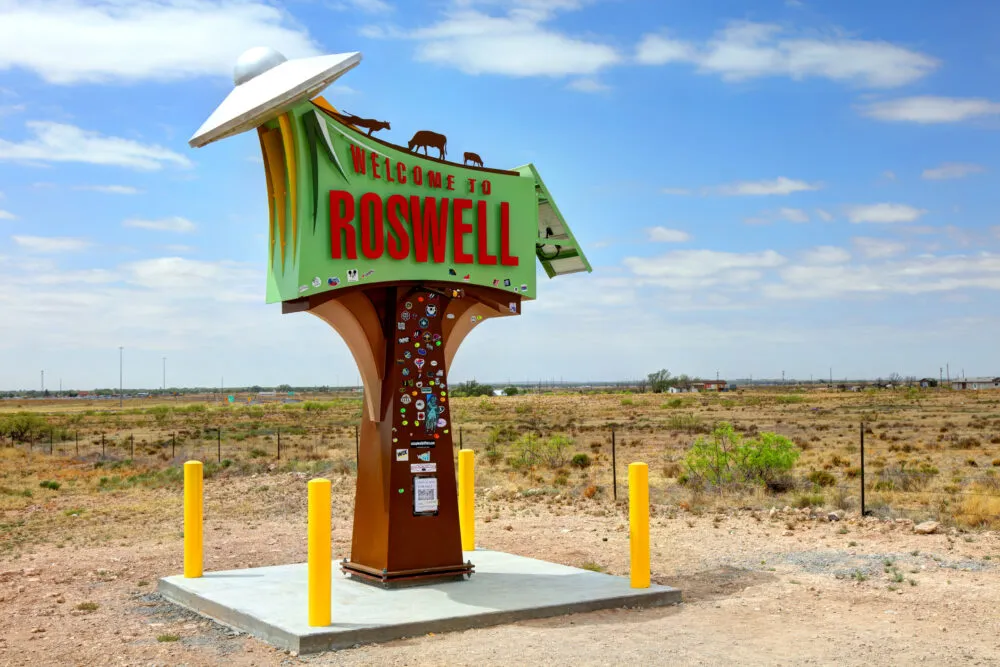During the Roswell incident, believers say an extraterrestrial spacecraft crashed in the New Mexico desert, with debris – and possibly alien bodies – recovered by the US government, marking the beginning of a decades-long cover-up.
What really happened at Roswell, and why does this mystery still attract such interest and controversy, decades later?
Read our interview with historian Greg Eghigian on the history of flying saucer and UFO reports.
Read more:
The Roswell UFO story begins
The Roswell UFO incident begins on 24 June 1947 when pilot Kenneth Arnold was flying over the Cascade Mountains of Washington State in the US, helping to search for a crashed military aircraft.
He saw 9 crescent-shaped objects flying in formation at a height of around 3km (10,000ft) and an estimated speed of approximately 1,900km/h: seemingly impossible at the time.
Arnold described the jerky movement of the objects as being, "like a saucer would if you skipped it over water."
The media got hold of the story, coined the phrase ‘flying saucer’ and a modern mystery was born.

This wasn’t the first sighting of what we now call a UFO (unidentified flying object), but it was the first to capture the public imagination, making news headlines around the world.
More reports were received, suggesting these sightings were commonplace but had previously gone unreported.
As this ‘summer of the saucers’ progressed, media coverage intensified to a point of near-hysteria, until matters came to a head and it seemed the mystery might be resolved.
Debris discovered at Roswell
On 7 July a local rancher named ‘Mac’ Brazel contacted the sheriff in Roswell to say he’d discovered strange debris spread over the ranch.
He’d found it days earlier but hadn’t thought much of it until the stories about flying saucers emerged.
Thinking there might be a connection and guessing something might have crashed during a recent storm, he alerted the authorities.
He’d brought some samples of the debris, and when the sheriff contacted the nearby Army airbase, intelligence officer Jesse Marcel went to the crash site with Brazel and recovered more debris.

The military base’s public information officer, Walter Haut, worked with a local journalist to release a newswire report about the event:
"The many rumors regarding the flying disc became a reality yesterday when the intelligence office of the 509th Bomb Group of the Eighth Air Force, Roswell Army Air Field, was fortunate enough to gain possession of a disc through the cooperation of one of the local ranchers and the sheriff’s office of Chaves County.
"The flying object landed on a ranch near Roswell sometime last week. Not having phone facilities, the rancher stored the disc until such time as he was able to contact the sheriff’s office, who in turn notified Major Jesse A Marcel of the 509th Bomb Group Intelligence Office.
"Action was immediately taken and the disc was picked up at the rancher’s home. It was inspected at the Roswell Army Air Field and subsequently loaned by Major Marcel to higher headquarters."
The news sent shockwaves around the world, but it’s the iconic front page headline of the local Roswell Daily Record that’s best-known: 'RAAF Captures Flying Saucer on Ranch in Roswell Region'.

US military u-turn
Within 24 hours there was a stunning development.
In a complete reversal of their position regarding the Roswell incident and debris discovery, the US military said a mistake had been made, and that the ‘flying saucer’ was a crashed weather balloon.
The Roswell Daily Record printed a follow-up story that read ‘Gen. Ramey Empties Roswell Saucer’ – General Roger Ramey being the Commander of the Eighth Air Force, to whose Fort Worth headquarters the debris had been flown.
A series of photos were published showing Ramey, Marcel, and other military personnel holding some of the debris. Sure enough, it looked pretty uninspiring and was entirely consistent with the ‘tinfoil’ mentioned by the military in their explanation.

Nowadays, with the 24/7 news cycle, internet, social media and an activist community of UFO researchers, such a claim – followed by such an about-turn – would no doubt cause controversy and conspiracy theories on a massive scale.
This is especially true given that the 509th Bomb Group was the only atomic bomb-capable squadron anywhere in the world at the time.
It’s hard to imagine these elite personnel – many of whom were familiar with weather balloons – being fooled in this way.
But post-war America was very different from today, and in that calmer, more trusting-of-authority era, the weather balloon explanation was almost universally believed.
While interest in flying saucers and UFOs went from strength to strength, Roswell disappeared from the narrative.
The Roswell UFO plot thickens

The story of the Roswell UFO incident was rediscovered in 1978 by nuclear physicist-turned-ufologist Stanton T Friedman, who was tipped off that a retired military man had an interesting story to tell: none other than Jesse Marcel.
Marcel told Friedman the weather balloon explanation had been a cover story and that the photos had been staged, with weather balloon debris being substituted for the real wreckage.
He claimed that everyone involved in the retrieval was clear the object had indeed been an extraterrestrial spaceship.
Over the next few years, researchers dug deeper into the mystery, tracking down many of the key players, locating additional witnesses and trying to piece together what happened.
A number of retired military personnel who’d been based at Roswell corroborated some elements of the crashed spacecraft narrative and added their own details.
Sceptics argued that they were simply telling the researchers what they wanted to hear, writing themselves into the story either as a prank, or because they were seeking attention.
Either way, books were written, documentaries, drama series and a movie were made, and the idea of a UFO crash became so embedded in pop culture that even if people had no particular interest or belief in UFOs, there was a good chance they had heard of Roswell.
Roswell incident in the 1990s

By now fact and fiction were getting blurred, and the narrative was incorporating other UFO conspiracies.
It was claimed, for example, that the wreckage from the Roswell incident had been taken to Area 51 (a remote facility in the Nevada desert where the US developed and test-flew aircraft like the U-2, the SR-71 Blackbird, and stealth fighters and bombers), where attempts were made to reverse-engineer the alien craft.
Such storylines would subsequently turn up as plots in movies like Independence Day and TV shows like The X-Files.
In 1995 a video emerged purporting to show an ‘alien autopsy’ which, it was implied, was connected to Roswell.

The film was a fake, of course, but it generated international news, with the hoax footage subsequently forming the basis of a comedy film starring UK TV presenters Ant and Dec.
During the 1990s the US government succumbed to media and public pressure, launching their own retrospective investigation and publishing two reports, the first in 1994 and the second in 1997.
The conclusion was that the culprit was indeed a high-altitude weather balloon, but that it had been carrying equipment designed to search the atmosphere for evidence of Soviet nuclear tests as part of something called Project Mogul.
Sceptics say the highly-classified nature of this monitoring project explains any apparent oddities in the handling of the incident.
It’s even possible that the flying disc story was a local initiative designed to throw the media off the true story, with higher command subsequently overruling the plan and saying it was a weather balloon.
The second government report, the release of which coincided with the 50th anniversary of the incident, was arguably guilty of over-egging the pudding.
None of the original reports had mentioned alien bodies, and even Jesse Marcel denied this aspect of the story, which only emerged later.

But the United States Air Force felt they had to address the issue and their convoluted theory suggested that people had conflated the 1947 crash with tests in the 1950s, in which anthropomorphic crash test dummies had been dropped to test the efficacy of military parachutes.
Even for neutral recipients, this was a stretch, and was met with predictable derision.
By this time, however, the story of Roswell had become the UFO community’s flagship case.
The city of Roswell had embraced its heritage, a UFO museum had been opened and annual events were held to mark the occasion.
Roswell now has such name recognition that several US presidents have alluded to the UFO incident in speeches and interviews, usually making light-hearted quips, but sometimes – seemingly – playing it sufficiently straight to make people wonder.
Legcay of the Roswell incident

Fast forward from the beginning of the Roswell incident to now. The topic of UFOs has been steadily transitioning from fringe to mainstream over the last few years – at least in the US.
This process started in December 2017 with two related scoops from The New York Times: firstly, the revelation that the US Navy had videos of UFOs taken from some of its fast jets, and secondly, the existence of the Advanced Aerospace Threat Identification Program (AATIP).
The exact role of AATIP is still the subject of dispute, but the Pentagon confirmed that it did – in part – study UFO data.
This is significant because previously the US government said that official interest in the topic ceased at the end of 1969, when an old Air Force program, Project Blue Book, had been terminated.
The New York Times story was seized upon by Congress, and classified briefings followed, with a number of high-profile politicians – Republicans and Democrats alike – speaking out on the issue.
In summer 2021 the Office of the Director of National Intelligence published an inconclusive preliminary assessment that stated most of the sightings studied remained unexplained.
More recently, multiple UFO-related provisions were included in the Defense Bill, requiring the Department of Defense, the military and the intelligence community to work together to resolve the mystery.

Congress wants to know if these mystery objects are drones operated by an adversary such as Russia or China, or something else.
Seemingly, nothing has been taken off the table, and this has sent the UFO community into a predictable frenzy.
All this means that the 75th anniversary of the Roswell incident is significant.
It isn’t just an opportunity for the local community to put on its usual parade and conference.
Rather, Roswell is in the spotlight again, representing a sort of ‘ground zero’ of the UFO phenomenon.
As the event passes from living memory into history, we may never resolve the mystery, but the story speaks to our wider fascination with one of the biggest and most profound questions we can ask: whether or not we’re alone in the Universe.
Fact or fiction? What do you make of the Roswell incident, and UFO stories in general? Let us know by emailing contactus@skyatnightmagazine.com.
This article originally appeared in the July 2022 issue of BBC Sky at Night Magazine.
